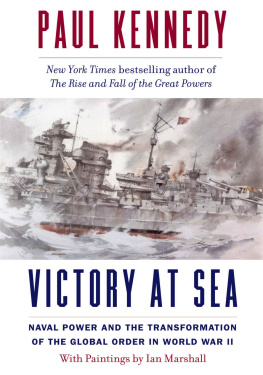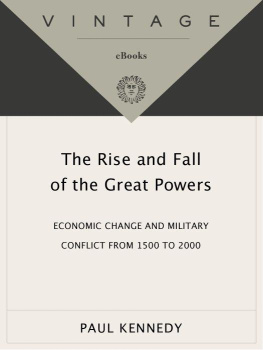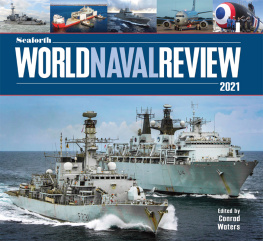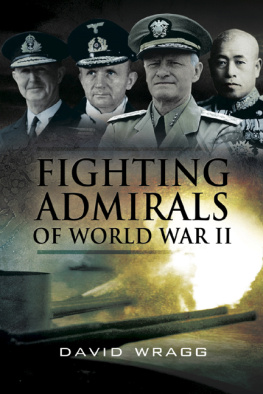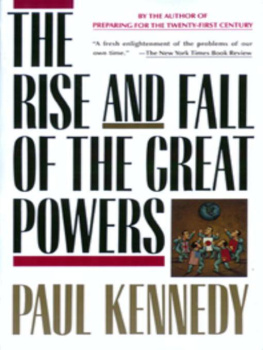VICTORY AT SEA


VICTORY AT SEA

NAVAL POWER AND
THE TRANSFORMATION OF
THE GLOBAL ORDER IN WORLD WAR II
PAUL KENNEDY
with paintings by
IAN MARSHALL
Yale UNIVERSITY PRESS
NEW HAVEN AND LONDON
Published with assistance from the Kingsley Trust Association Publication Fund established by the Scroll and Key Society of Yale College.
Copyright 2022 by Paul Kennedy. Original paintings by the Estate of Ian Marshall.
All rights reserved.
This book may not be reproduced, in whole or in part, including illustrations, in any form (beyond that copying permitted by Sections 107 and 108 of the U.S. Copyright Law and except by reviewers for the public press), without written permission from the publishers.
Yale University Press books may be purchased in quantity for educational, business, or promotional use. For information, please email (U.K. office).
Maps by Bill Nelson.
Designed by Amber Morena.
Set in Minion Pro type by Motto Publishing Services.
Library of Congress Control Number: 2021945484
ISBN 978-0-300-21917-3 (hardcover : alk. paper)
A catalogue record for this book is available from the British Library.
This paper meets the requirements of ANSI/NISO Z39.48-1992 (Permanence of Paper).

To Cynthia and Jean
From Paul and Ian
Contents
by Ian Marshall
Paintings by Ian Marshall
Luetzow and Scharnhorst, Narvik fjord, 1943
Maps
Charts and Tables
Charts
Tables
Preface
The present work is, first and foremost, a book about naval history; it tells a story of naval battles, maritime campaigns, hard-fought convoys, amphibious landings, and strikes from the sea during World War II, and of the state of navies for a brief while before and after that. But as well as being a study of a mere ten years (193646) of maritime affairs, it is also a work that grapples with the larger story of the rise and fall of Great Powers in recent times. This is a naval tale, to be sure, yet in addition it is an analysis of power shifts in the international system at the time of the greatest hegemonic war in history. It is a study in the causes of historical change using the compressed time frame of a single decade, but this brief period was a very special one; at no other time in history did the naval balances of power change as much.
To be more specific as to the authors deeper intent: this work offers a novel attempt to trace and measure the dynamic growth of the United States of America, through the prism of its swift attainment of naval mastery at the close of the war years, to be the number one world power by 1945. The convoy struggles and the battleship shootouts described in detail here, then, are presented as the surface events of a larger struggle for world power; beneath and behind those naval campaigns, huge alterations were taking place in the international ordering of the leading countries of the globe. Perhaps only a few perceptive observers of the time saw it, but what was occurring was a seismic shift in the world order. Victory at Sea is about warships and navies, from beginning to end, but it is also about that extraordinary shift in Great Power history.

A few years ago I really did not think I would be writing another work about World War II, especially not one about navies. I was drafting a new introduction and conclusion to a twenty-fifth anniversary edition of my earlier book, The Rise and Fall of the Great Powers, and also collecting materials for a possible study of Kiplings imperial thought. That would be plenty. But a conjuncture of circumstances occurred, beginning with various surgeries that kept me close to home and away from the UK libraries that I wished to work in. It was during those nontraveling months that I offered to write the foreword, and later an accompanying text, to my friend Ian Marshalls planned new collection of his original paintings of Fighting Warships of the Second World War. For a little while, I could take time away both from Kipling and from my reflections on what had been happening to the Great Powers since the first edition of Rise and Fall. It would be easy to compose a simple narrative of the maritime events of the period 193945. And it would be fun to work with a renowned maritime artist (Ian had just been elected the president of the American Society of Marine Artists). With the support of Yale University Press, a publisher who would respect the need to integrate Ians paintings into the specific chapters and narrative of this book, I commenced drafting.
After a further year or so, when I had returned to teaching at Yale, other changes had occurred. The first was Ians sad and unexpected passing, at home, just before Christmas 2016. He was an artist of remarkable and original talent, as those who possess his beautiful books on Armored Ships, Flying Boats, Cruisers and La Guerre de Course and Passage East well know. He had been painting almost to his very end, however, and sending fresh naval portraits from his studio to me as well as detailed, fully researched descriptions of all the works already completed; it seemed only properindeed, I was compelledto finish and have published our joint project. I miss his gentle manners, his great professionalism, and his remarkable erudition in the realms of maritime history and warship design. Each painting is not only a fine work of art but also an understated display of Ians impressive topographical and historical knowledge.
The other major change from the original plan was an intellectual one, which had slowly taken shape while I was thinking about and drafting the middle chapters of this book. The more I saw the story unfold, from those early successive blows by the Axis on the Anglo-American navies (Norway, the Fall of France, Crete, Pearl Harbor, Manila, and Singapore) to the amazing turnaround of fortune in the midst of this gigantic conflict, the more motivated I was to return to probing the deeper reasons for the transformation. Ians illustrations alone, even as I was choosing where to insert them, were telling us something here. One painting for the year 1940 showed a battle-worn destroyer disembarking British troops after the Dunkirk disaster (). In a mere two years, more or less, the world had changed.
Something had happened to cause this huge alteration in the maritime balances, and it simply wasnt enough to state that the US Navy was by now sending more and more new aircraft carriers to the Pacific and therefore was able to advance. Somewhere around the middle period of this great war at sea, more exactly as the critical year of 1943 unfolded, a massive shift in the global balance of power took place, a change of fortunes that was both reflected in and helped by alterations in the naval balances themselves. Obviously, this was not the first time that epic, interacting transformations in history had occurred. Century after century, great conflicts between the powers really did change the relative position of states, just as they changed the nations themselves. Had not the distinguished sociologist Charles Tilly, writing of Europes rise in early-modern times, coined that reciprocal phrase, War made the State, and the State made War? In our case we might say:
Next page
